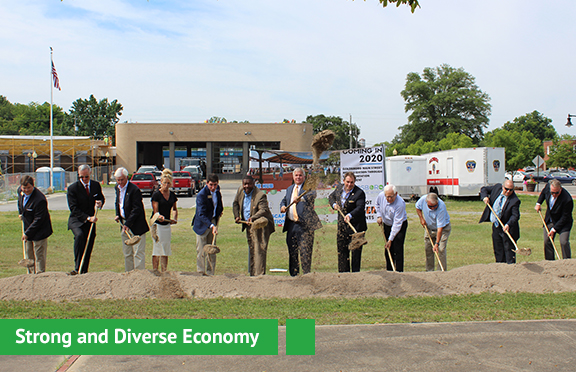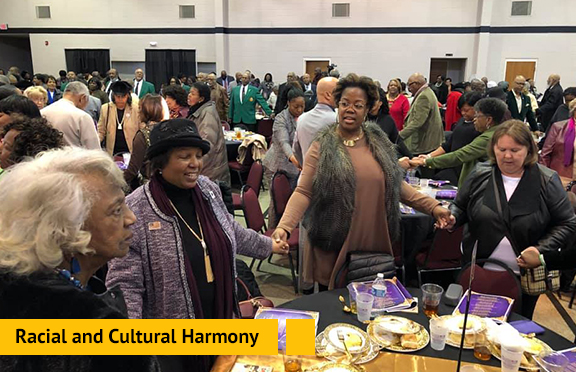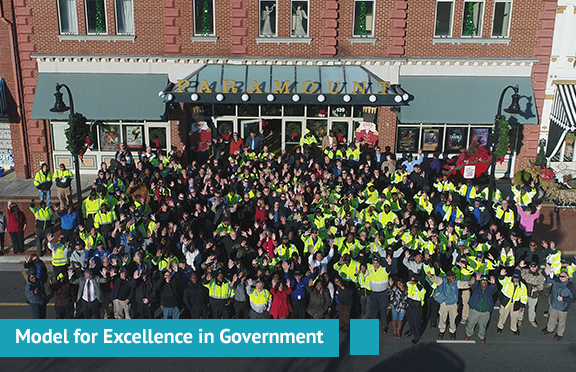Strategic Plan

The City’s Strategic Plan is an organizational plan intended to help the City make the most efficient use of our resources in becoming the standard for public service in North Carolina. The City Council created the goals based on survey input from citizens and city employees. The Strategic Plan incorporates departmental metrics that are tracked and measured for accuracy. The values of being customer-focused, having transparency and accountability are critical success factors for achieving the city’s target goals.
If you have questions or comments, contact Octavius Murphy, assistant to the city manager, at 919-580-4351 or omurphy@goldsboronc.gov.
Mission Statement
The City provides services, promotes equality, and protects the well-being of all residents and visitors to enhance our quality of life every day.
Vision Statement
An extraordinary, diverse experience.
Goals
Safe and Secure Community
Strong and Diverse Economy
Exceptional Quality of Life
Racial and Cultural Harmony
Model for Excellence in Government
Values
Professionalism — We work with the guiding belief that competence, resourcefulness and courtesy will exceed expectations.
Integrity — We act honestly, morally, ethically and reliably to serve and represent our community.
Customer-focused — We listen to resolve issues, respond timely and ensure citizens’ satisfaction first.
Use these buttons to explore our Strategic Plan
The number of Part I Crimes per 1000 people. Part I Crimes include Crimes Against Persons (Homicide, Aggravated Assault, Rape (not included in the NC rate until 2019)) and Crimes Against Property (Robbery, Burglary, Larceny, Motor Vehicle Theft, and Arson).
The "Target" is less than the average for NC municipalities of comparable population size (25,000 - 49,999); "Close to Target" is within 25% of the average; anything else "Needs Improvement".
The Goldsboro Police Department (GPD) has hired and retained more police officers, modernized its vehicle fleet, and renovated the Public Safety Building to meet Commission on Accreditation for Law Enforcement Agencies (CALEA) standards. The GPD has expanded its data driven capabilities such as ShotSpotter and Mobile Field Reporting software to streamline reporting and make our PD more efficient and effective at investigating and solving crime.
The GPD defines the targets and reports the data to the FBI Uniform Crime Reporting (UCR) database which uses US Census Bureau population data to determine the annual crime rate.
The City of Goldsboro is committed to providing a safe and secure community. While our current crime rate is almost twice the state average, it has dropped 20% over the last 4 years.
The percentage of the Part I Crimes reported to the Goldsboro Police Department (GPD) that are cleared by the officers and/or investigators on an annual basis. Cleared refers to gathering enough evidence to support an arrest or encountered a circumstance outside the control of law enforcement that prohibits the agency from arresting, charging, and prosecuting the offender. Crimes are categorized as Violent (Homicide, Forcible Rape, Robbery and Aggravated Assault) and Property (Burglary, Larceny, Motor Vehicle Theft and Arson).
The "Target" is greater than the average for U.S. municipalities of comparable population size (25,000 – 49,999 residents), with the average Clearance Rate for Violent Crime being 45.5%, and Property Crime at 17.2%; "Close to Target" is within 15% of the average; anything else "Needs Improvement".
The GPD has made investments in advanced technologies, case management software, and training, greatly expanding the department’s ability to investigate crimes both traditionally and forensically; ultimately leading to an increase in arrests. The GPD has hired a civilian crime scene analyst and will hire a civilian crime scene technician to better document and solve crime.
The GPD defines the targets and collates the data with state and national statistics which are managed and published by the State Bureau of Investigation (SB) and the Federal Bureau of Investigation (FBI) annually.
Solving and ultimately preventing crime is the goal of the GPD. We have a responsibility to the victims of crime to make every effort to reach a legal conclusion and closure. The Clearance Rate provides us with a unit of measure to focus criminal investigation and crime prevention efforts. The GPD is above average for solving property crime but below targets for violent crime.
The percentage of time the City meets all federal and state drinking water standards. The City measures its compliance relative to primary maximum contaminate levels and treatment techniques. The indicator is calculated on a rolling annual basis as follows: Percent of Drinking Water in Compliance = # of days City was in full compliance with all applicable regulations / 365.
The "Target" is 100%; "Close to Target" is greater than 99.5%; anything less "Needs Improvement"
The City of Goldsboro makes every effort to provide safe potable water. On a daily basis, the water plant staff runs bacteriological and other laboratory analyses on the drinking water before it is sent to our customers. Through this monitoring process, the City can assure its water customers that the water supply meets all National Drinking Water Regulations.
The Public Utilities Department defines the targets; Water Treatment Plant (WTP) staff collect numerous samples daily to monitor the quality of the water.
The City of Goldsboro strives to meet all National Drinking Water Quality Standards and regulatory requirements through its treatment processes. In the event a regulatory sample exceeds the action level, the North Carolina Department of Environmental Quality will be notified and water customer notification and guidance will follow per state guidelines.
The percent of incidents where in the fire cause is determined.
The "Target" is greater than the UNC SoG Benchmark Study average; "Close to Target" is within 10% of the average; anything else "Needs Improvement".
The Goldsboro Fire Department (GFD) strives to meet and or exceed all local, state, federal, and professional standards. In FY 21-22, the GFD plans to transition the part-time inspector position to full time. This will allow the Fire Marshal to focus on fire cause determination. Additional funding has been obtained that will allow for entry and advanced level training. The ability or inability to determine fire cause can assist in determining if additional personnel, training, and or public education programming is needed.
The GFD defines the targets and reports all call and response information into a National Fire Incident Response System (NFIRS) compliant records management system (FireHouse) for analysis on a monthly basis.
By measuring against the benchmark, the GFD is able to determine the effectiveness of our fire investigation efforts. The ability/inability to determine origin and cause is essential for the identification of trends, prosecution of criminals, and providing a safe environment in the community.
Percentage of Code Violations Cleared within 90 days. Clearance refers to either correction or imposition of a fine.
The "Target" is greater than the UNC SOG Benchmark Study average; "Close to Target" is within 5% of the average; anything else "Needs Improvement".
The Goldsboro Fire Department (GFD) strives to meet and or exceed all local, state, federal, and professional performance standards. The GFD has increased the inspection requirements, the part-time inspector will transition to a full time position to assist with all aspects of fire inspection/prevention programming. The transition to a full time position will enhance the GFD’s ability to clear violations and directly contributes to the safety and security of all citizens, members, and guests.
The GFD defines the targets and reports all call and inspection information into a National Fire Incident Response System (NFIRS) compliant records management system (FireHouse) on a daily basis. The target data is updated on a monthly basis.
An effective program is one wherein the identified violations are corrected in an expeditious manner. This enhances the safety for all.
The percentage of time a full complement of fire trucks and personnel arrive on the scene of a structural fire emergency within 8 minutes per National Fire Protection Association (NFPA) standards.
The "Target" is greater than the UNC SOG Benchmark Study average; "Close to Target" is within 5% of the average; anything else "Needs Improvement."
The Goldsboro Fire Department (GFD) strives to meet and or exceed all local, state, federal, and professional response standards. Assets are strategically placed across the city to promote rapid response to emergencies. The ability or inability to meet the “full response” standard can provide information that can be used to validate station locations, expose poor operational procedures, or justify additional personnel.
The GFD defines the targets and reports all call and response information into a National Fire Incident Response System (NFIRS) compliant records management system (FireHouse). The target data is updated on a monthly basis.
By measuring against the benchmark, the GFD is able to determine the effectiveness in providing adequate resources to our residents on a consistent basis. The presence of an adequate response assignment enhances incident safety and capabilities.
The percent of site plan and subdivision development applications that are completely processed within 35 days (subject to council and/or staff approval).
The "Target" is 100%; "Close To Target" is greater than 80%; anything less "Needs Improvement".
The City prides itself on ensuring projects are handled in a professional, timely, consistent and accurate manner with the use of Plan Review Software and Qualified Staff to streamline the review process.
The Planning Department defines the targets and tracks the number of site and subdivision plans submitted on a monthly basis using Energov Plan Review Software.
The Planning Department is dedicated to streamlining and consolidating the development review process to ensure projects succeed within the confines of adopted rules and regulations. Project review time is critical to economic growth within the City.
The amount of investment in Downtown Goldsboro infrastructure from other funding sources (i.e. County, State, Federal, and Private) in comparison to City funded investment (e.g. Streetscape, Public Safety Complex, Paramount, Union Station).
The "Target" is greater than a 2 to1 match, or 200%; "Close to Target" is grater than 1:1, or 100%; anything less "Needs Improvement".
Since 2013, the City leveraged its Downtown Master Plan and has invested $12M to attract $39M: $16.4M of State and Federal funding and $22.6M in private investments. Thus, the City’s investment has been matched 3.2:1. City investment includes improvements to Streetscape, the Police/Fire Complex, City Hall, Paramount, Union Station and Amenities/Landscaping. The Downtown Development Department (DDD) will continue to work with its private Non-profit Organization (NPO) partner, Downtown Goldsboro Development Corporation (DGDC), to execute a work plan that facilitates additional public and private investments.
The DDD defines the targets based on Main Street Community data (64 NC Cities < 50K population) and tracks Fiscal Year (Jul - Jun) public and private investment. The metric start date is 2013 and associated with Phase 1 of the Streetscape Project.
Tracking tangible outcomes resulting from the City's investments allow justification of spending and set the stage for future development.
The percent increase of market-rate residential units in the Downtown Municipal Service District (MSD) over a three year period.
The "Target" is an increase greater than 30%; "Close to Target" is an increase greater than 15%; anything less "Needs Improvement."
The Downtown Development Department (DDD) has marketed available properties that are suited for residential development, which will add 68 new apartments over the next year increasing our market-rate units by 85%. Working with existing property owners and perspective investors, our goal is to position the properties for successful transition and redevelopment. DDD is also working to recruit thoughtful and contextual infill development to grow our economy.
The DDD defines the targets and captures residential property information each Fiscal Year (Jul - Jun) as part of a North Carolina Main Street requirement.
The City of Goldsboro strives to attract a healthy balance of development, as downtown residents have the capacity to stimulate the local economy. The estimated economic impact of downtown residents is $9,000 per person, annually, in the commercial business district. This provides a stronger economic environment, reducing risk for investors and business.
The percentage of current water demand compared to Water Treatment Plant (WTP) capacity. Five-year average water production / Current water production capacity.
The "Target" is the top quartile of American Water Works Association (AWWA) Benchmarking Survey Respondents, <38%; "Close to Target" is between the top quartile and the median of the desired target, <47%; "Needs Improvement" is greater then the Median.
Through monitoring peak demands and water production capability, The City of Goldsboro is able to ensure its ability to produce enough water to support its residents and visitors. The City also invested in WTP plate settlers to increase capacity from 12 Million Gallons per Day (MGD) to 14 MGD; this is expected to be complete in 2021.
The Public Utilities Department defines the targets; WTP staff record daily water production into monthly operating reports. At the end of each calendar year, staff evaluates this data for the Local Water Supply Plan to determine current water demand compared to available water supply.
The City of Goldsboro strives to ensure there is an adequate supply of drinking water for their residents, businesses, and visitors. The City is going through a rate study in FY 20-21 to prepare the water system for future demand, regulations, and infrastructure over the next 10-years.
The percent of wastewater demand compared to water reclamation facility capacity. One-year average wastewater treatment / Current wastewater treatment capacity.
The target is a performance better than (a lower %) or equal to the average North Carolina Benchmarking Survey Respondents, ≤55%: "Close to Target" is ≤70%; any thing else is "Needs Improvement".
Through monitoring peak demands and wastewater treatment capability, The City of Goldsboro is able to ensure its ability to treat enough wastewater to support development its residents and visitors. The City expects to undertake a master plan update, addressing capacity and optimization concerns.
The Public Utilities Department defines the target; Water Reclamation Facility staff record daily wastewater treatment flows into Daily Monitoring Reports. At the end of each calendar year, staff evaluates this data to determine treatment capacity in relation to the 80/90 Rule for plant design and/or expansion.
The City of Goldsboro strives to ensure there is adequate wastewater capacity for future development, their residents, and visitors. The target is set to be better than the average North Carolina Benchmarking Survey Respondents.
The monetary value of Commercial and Residential permits registered annually with the City.
The "Target" is a rolling average over the last 5 years; "Close to Target" is within 15% of the average; anything less "Needs Improvement".
The state building codes requires the Inspection Department to use its resources to educate the public, general contractors, sub contractors, and homeowners on requirements for obtaining the proper permits.
The Inspections Department defines the targets and collects this data on a yearly basis through our Inspection/Permit Energov Software.
This is an indicator of growth and stability within our City.
The percent of population within one mile of a City owned Park or Recreational Facility.
The "Target" is 100%; "Close to Target" is 85% or greater; anything less "Needs Improvement".
The City has approved $11 millions for construction of the new Herman Park Center and constructed two additional Parks or Recreational Facilities (Bryan Multi-Sports Complex and Stoney Creek Skate Park). According to the UNC-School of Government, the City of Goldsboro has the most pools, athletic fields, and playgrounds per 10,000 population.
The Parks and Recreation Department defines the targets and tracks this data annually.
The City's residents and visitors may face challenges to living a healthy lifestyle without affordable access to Parks and Facilities that provide physical activity. We are still in need of a City park or facility in District 6 (15% of the population).
The percentage of streets that do not meet the Pavement Condition Rating (PCR) of good (80) or greater on a scale of 0-100 qualifying the roughness, surface distress, skid resistance and deflection.
The "Target" is below the average for US cities of the same population size; "Close to Target" is within 10% of the average; anything greater “Needs Improvement.”
In 2016, residents of Goldsboro passed a $7 million Infrastructure Bond to go towards street resurfacing and dirt street paving. Near the beginning of this process in 2017, the percentage of streets that did not fall in the 80-100 rating was 60%. After two rounds of projects, the percentage in 2019 moved closer to the target with a 50% of the streets falling outside of the 80-100 rating. The final bond money projects will be completed this year and should continue to move the metric to the targeted goal. Since pavement conditions continuously degrade, appropriate annual funding is a vital part for the success of this departmental metric.
The Engineering Department defines the targets and manually performs a pavement condition survey. The survey is performed by conducting a “windshield” survey of all 159+ miles of streets in our maintenance inventory and assigning a rating based off various pavement distresses identified during the survey. These ratings are performed on every street segment within our maintenance inventory every 3-5 years, as recommended by the Institute of Traffic Research Engineering (ITRE), and updated as maintenance is performed.
Evaluation of transportation assets is an important part of ensuring safe and efficient travel and movement of goods. Thus, decisions associated with maintaining or rehabilitating transportation assets are paramount to the sustainability, cost-effectiveness, and overall satisfaction of our streets.
The percent of the City’s total annual “pothole repairs” completed within 24 hours of notification.
The "Target" is 95% or greater to be in the top quartile of the UNC SoG Benchmarking Study respondents; "Close to Target" is 90% or greater; less than 90% “Needs improvement.”
Through efficient pothole monitoring and oversight, the City of Goldsboro has been able to effectively maintain the streets. To ensure continued success, the City invested $280K in a new pothole patcher during FY 19/20
The Public Works Department defines the targets; Street Maintenance Division maintains records and tracks all pothole and utility cut repairs real-time. The data is consolidated and used to determine the overall percentage of repairs completed within 24 hours of notification.
By monitoring this metric, we are better able to ensure the City meets and/or exceeds citizens expectations.
The percentage of youth (under 18) engaged in Paramount Theatre cultural arts programming.
The "Target" is greater than 35%; "Close to Target" is 30% or greater; anything less "Needs Improvement."
The Paramount Theatre allocates 10%-15% of its annual budget to performing arts series, film showings, and dozens of community performances each year. These varied means of participation allow for youth to be involved both actively and passively with the cultural arts. By tracking this metric we ensure that budget is allocated in ways that engage our youth and provide present and future benefit.
The Paramount Theatre Department defines the targets and works closely with programming initiatives with Wayne County Public School (WCPS), Goldsboro's StageStruck youth theatre, the Boys and Girls Club and other community organizations to encourage student involvement. The targets will be updated annually.
As measured by US News and World Report, all top 25 places to live in the US for quality of life have strong arts programming. Studies consistently show that individuals of all ages involved in the arts either actively or passively, demonstrate improvement in emotional health, stress, and anxiety; they display higher levels of motivation, engagement, self-esteem, and life-satisfaction. The youth benefits include strong improvement in academic achievement, social skills, creativity, critical thinking, language, and reading.
The number of owner occupied low and very-low income single-family homes rehabilitated through grant funds obtained by the Community Relations Department (i.e. North Carolina Housing Finance Agency (NCHFA) through the North Carolina Housing Trust Fund, the Urgent Repair Program (URP) for the purpose of repairing their homes and removing health and safety hazards by replacing costly maintenance items).
The "Target" is to complete urgent repair work to at least 15 owner-occupied housing units within a fiscal year; "Close to Target" is 10 or greater; anything less "Needs Improvement".
The Community Relations Department coordinates closely with residents to prevent foreclosure, age-related deterioration, rising maintenance and utility costs, demolition, and expiring use restrictions and affordability controls for low and very-low income homeowners.
The Community Relations Department defines the targets and reports this data to the NCHFA quarterly and annually.
This effort keeps families in their homes and prevents home abandonment and deterioration. Viable and affordable communities have been shown to have a neutral or positive effect on surrounding property values.
The percentage of all City employees who receive Cultural Diversity and Sensitivity Training.
The "Target" is greater than 90%; "Close to Target" is greater than 75%; anything less "Needs Improvement".
The City strives to provide professional development to all employees. Our on-line portal makes it possible for all employees to access voluntary and mandatory training.
The Human Resources Department defines the targets and collects the data from all training sessions each fiscal year. On-line Professional development is provided to meet U.S. Department of Labor, Society of Human Resource Management (SHRM), International City Manager Association (ICMA), NC Office of State Personnel, and UNC School of Government (SOG) training recommendations.
This training is designed to improve employee relations and provide better customer service.
The percentage of board member diversity on all the City’s boards and commissions based on race. Racial diversity includes non-white (African-American, Native American, Hawaiian, Asian, Hispanic, and two or more races).
The "Target" is within +/-10% of the City racial diversity, which is 59%; "Close to Target" is within +/-20%; anything else "Needs Improvement".
The City of Goldsboro utilizes volunteer boards to provide advice to the city council from a diverse citizen perspective. To assure transparency, vacancies are advertised on social media, in the Goldsboro News Argus and on the city’s website. Applications for boards and commissions are posted on the city’s website or are available at City Hall.
The City Manager’s Office defines the targets and tracks appointments to the various boards and commissions on a yearly basis as terms end.
The City Council recognizes and values the importance of a diverse citizen participation in local government and strives to select citizens from the entire community to serve on boards and commissions. The City Council takes into consideration the racial ethnicity of residence on a geographical basis.
The annual percentage of U.S. Department of Housing and Urban Development (HUD) Community Development Block Grant (CDBG) funds expended by the City for activities that benefit low-to-moderate income (LMI) persons.
The “Target” is 90 percent or greater of the HUD LMI benefit test annually; “Close to Target” is 70% or greater, which is the HUD standard; anything less “Needs Improvement”.
The Community Relations Department coordinates closely with citizens, Councilmembers, community agencies, and the U.S. Department of Housing and Urban Development (HUD) to develop viable urban communities through decent housing, suitable living environments, and expanding economic opportunities mainly for persons of low to moderate income.
HUD defines the target as all CDBG funds included in a designated fiscal year, except for funds used by the City for program administration or for planning activities, to meet the required aggregated percentage of not less than 70% used for activities that benefit LMI persons.
The City maintains its status as an "Entitlement Community" by executing our local strategies and continues to receive its annual CDBG and HOME allocation from HUD to meet LMI citizen needs.
The percentage of the City’s vehicle and equipment fleet (rolling stock) available per day.
The “Target” is ≥ 98%; Close to Target is a rate greater than 95%, but less than 98%; anything less “Needs Improvement”.
The City of Goldsboro strives to ensure our vehicle and equipment fleet is readily available for staff to provide needed services. The City invests annually in the training and development of quality mechanics to maintain the fleet. The City's capital investments over the past few years includes the purchase of a $1.3M ladder truck for the Fire Department, $280K street sweeper, $200K semi-tractor, and $185K pothole patcher for Public Works, and over 30 new police cruisers.
The Public Works Department defines the targets, tracks and measures the rolling stock data to calculate the average percentage of the City’s vehicle and equipment fleet that is available daily and reported annually.
Maintaining this level of service provides all department users with the vehicles and equipment required to meet their various missions.
The percent of Goldsboro Metropolitan Planning Organization (GMPO) submitted projects accepted into the State Transportation Improvement Plan (STIP).
The "Target" is greater than 50% of projects submitted accepted into the STIP; "Close to Target" is greater than 30%; anything less "Needs Improvement".
The City, acting as lead planning agency for the GMPO, provides guidance for orderly growth and development by identifying transportation needs within the Goldsboro Urbanized Area. Federal and State planning funds granted to the GMPO allow for essential staff to properly plan and prioritize transportation needs within the urbanized area.
The Planning Department defines the targets and tracks highway transportation needs through a continuing, cooperative and comprehensive transportation planning process that results in a long-range transportation plan and short-range program of projects. Projects prioritized within these plans/programs can compete for Federal and State funding every two years.
Developing plans and programs that creates a regional transportation system that accommodates the current mobility needs of our residents and visitors is vital to the success of the transportation system. Tracking our needs allows for improvement of our existing network to accommodate future growth.
The percent of our full-time work force that is racially diverse. Racial diversity includes non-white (African-American, Native American, Hawaiian, Asian, Hispanic, and two or more races).
The "Target" is within +/-10% of the City diversity, which is 60%; "Close to Target" is +/-20%; anything else "Needs improvement".
The City strives to recruit a diverse workforce while hiring the best qualified applicants. We provide scholarships, tuition assistance, participate and sponsor career fairs, and increase recruiting efforts especially in departments that are less diverse.
The Human Resources (HR) Department defines the targets and compiles the statistics for internal and federal reporting purposes by fiscal year.
The City's workforce should broadly represent the diversity of the community we serve to better promote the city's vision, mission, goals and values.
The percent of time the City of Goldsboro Inspection Department responds to an inspection requested by the Development Community within 24 hours.
The "Target" is 93% or greater; "Close to Target" is greater than the UNC SoG Benchmark Study average, 89%; anything less "Needs Improvement."
The Inspection Department continues to build upon relations in the development community. The inspectors provide high levels of service to both residential and commercial developers when permits are requested. All inspector are required to maintain their state certification through continued education courses annually.
The Inspection Department defines the targets and provides the data to the UNC School of Government Benchmark Study which is published annually.
The Inspections Department ensures proper inspections are completed in a timely manner to meet resident and developer expectations.








